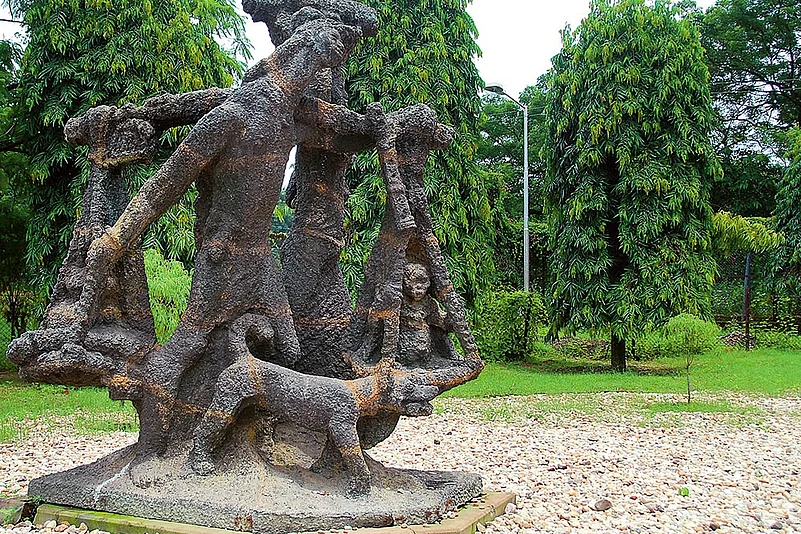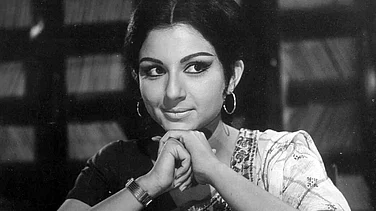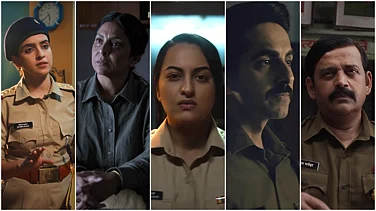The definition moves by contrast. Sculpture, they say, doesn’t open up space like a landscape painting: it occupies space. In India, it also occupies time. That petite, 10-cm-tall dancing girl of insouciant aspect—the archaeologist’s delight—is 4,500 years old. Between the Harappan artist who captured a kinetic moment on that tiny piece of bronze and those Buddhist architects who thought of carving immense sacred spaces out of sheer Deccan rock, there already spans two-and-a-half millennia. From there to the present, another two! Entire epochs that cast the celestial and the carnivalesque alike in a profusion of three-dimensional art.
Another contrast, then. The relative poverty of the modern age, the thinning out of the sculptural imagination, its withdrawal from centrestage, its surrender of primacy to painting, its very ambivalence about its status and relevance in the contemporary art world: all this is a new affliction. Trace it through time again. One subplot in the story of India’s visual culture in the last one-and-a-half centuries is bookended by two well-known dates: 1857 and 1947. It was in the year of rebellion that the country got a milestone institute: Sir J.J. School of Art in Bombay. Nine decades later, as India turned a chapter with the tricolour’s official ascension in New Delhi, a few sculptures started vanishing from Rajpath, the former imperial boulevard.
Today, in his home east of the Yamuna, octogenarian artist A. Ramachandran rues how they removed those “beautiful works” from around India Gate. “If we looked at them for their artistic merit, as opposed to being symbols of colonial legacy, we would not have dislocated them,” the painter-sculptor says. That may be a tad utopian, for those pieces of monumental art were indeed embedded in meanings of power. But their relegation to obscurity—in Coronation Park on Burari Road—speaks of a parallel movement. To him, India still has practically no sculptural representation because “we continue to follow the British concept of designating portraits for people and things that matter”.
These words come from an artist who has traversed both worlds—painting and sculpture. In one, the tonal life of old India (adivasi Rajasthan, Kerala temple murals) streams in through his modernist filters; in the other, the transfigured language of mass and volume that he firmed up as an alumnus of Santiniketan, where he learned under the iconic Ramkinkar Baij. He knows, therefore, the poorer cousin’s status sculpting has received in independent India. Painting has assumed the central place: it is seen as the prototype form of ‘art’ now. This relative valuation corresponds more to their variable visibility and marketability, which the very structure of gallery spaces furthers. All this while contemporary Indian sculptors gave us consistently high-quality works, barring a minor slide or two, as experts affirm.
Indeed, within the field there are signs of robust life and evolution. Recent trends have ushered in a paradigm shift of sorts. It’s not just about traditional mediums like metal, wood and stone giving way to materials such as silicone rubber, textile, e-waste, cardboard, even edible stuff. The new materiality is necessarily more fluid, seeping back and forth between old conceptual walls. Computer-generated sensory inputs bring in an element of augmented reality. Installation art is invading gall-ery space once slotted for conventional works. New-age architecture is again getting defined in terms of sculpture, recovering an old kinship, as virtual movement and kinetic art destabilise the solidity at the other end. The concept of dimensionality too has expanded, with even sound becoming part of sculpture.
This phase of experimentation has been on since the 1990s, according to critic Nancy Adajania. “The viewer today does not see the sculptural form secured in a single place, instead they witness the dematerialisation of the sculptural object,” says the Mumbai curator. “These experiments in sculptural language have not only changed prevailing viewership codes, but is allowing artists to confront caste, class, religion and gender, as well as philosophical questions related to the visceral body, mortality and sexuality.”
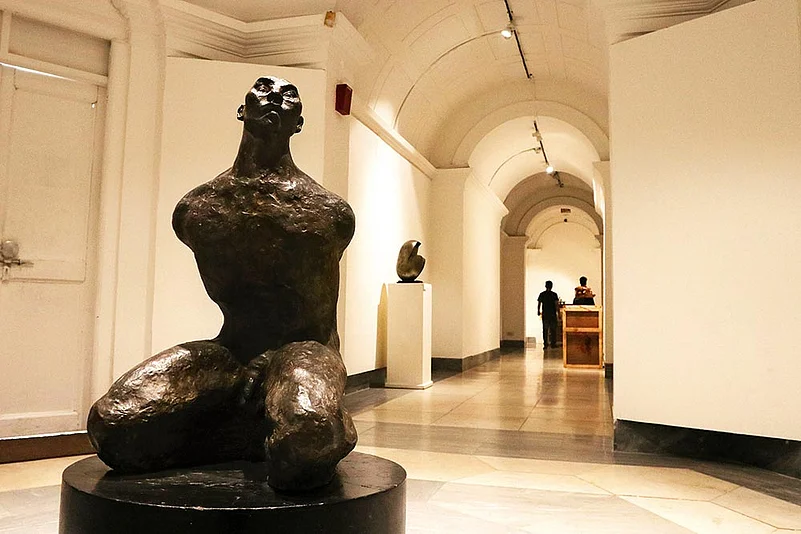
In Bondage by Prodosh K. Dasgupta
But there’s no escaping materiality in the basic circumstances. Veteran Bangalore artist S.G. Vasudev laments the everyday practical difficulties sculptors encounter. “To start with, you need a much bigger space and the investment cost is much higher compared to painting. Large sculptures are tough to transport; they involves more risk of breakage or deformity,” he points out. “No wonder, several exhibitions don’t accept terracotta sculptures. Small-format sculptures move faster comparatively.”
And yet, India has a rich roster of modernist sculptors—from D.P. Roy Chowdhury, Dhanraj Bhagat, Sankho Choudhuri, Somenath Hore, Sarbari Roy Choudhury, Amarnath Sehgal, Himmat Shah, G.C. Bhat, M.V. Devan and Mahendra Pandya et al to the later Sheela Gowda, Ravinder Reddy, Jitish Kallat, Jagannath Panda, Ashwini Bhat, Iranna G.R. and Alwar Balasubramaniam among others. Renowned painters like the late K.G. Subramanyan and Satish Gujral, 91, too have experimented with terracotta murals and architecture respectively. New names such as Subodh Gupta and Bharti Kher have of course come to be known more as installation artists than sculptors. Make-to-order is increasingly the norm.
Traditionally, the very public nature of sculpture inverted the visibility quotient—it’s paintings that occupied the niche space, says Dr Jayanta Sengupta, secretary-curator of Victoria Memorial Hall, Calcutta, generalising from the situation in Bengal. “Sculpture was not treated as inferior to painting. They occupy two distinct spaces,” he says. “Paintings here existed more in the domain of private collections, of royalty or others. Sculptures were more accessible to the common person. Architectural structures too are adorned outwardly by sculptures, not paintings,” adds Sengupta, who’s also director, Indian Museum.
The contrast with the present situation is rather stark. “Be it in a thematic or group show, say one out of ten works will be sculpture. Roughly, this is also the sculptor-painter ratio in India,” says Kishore Singh, director, Delhi Art Gallery. This, when an exhibit by 20th-century Swiss sculptor Alberto Giacometti was recently priced in London at over 100 million pounds (Rs 900 crore). “Well, that is actually our annual turnover (for sculpture sales in India),” Singh adds.
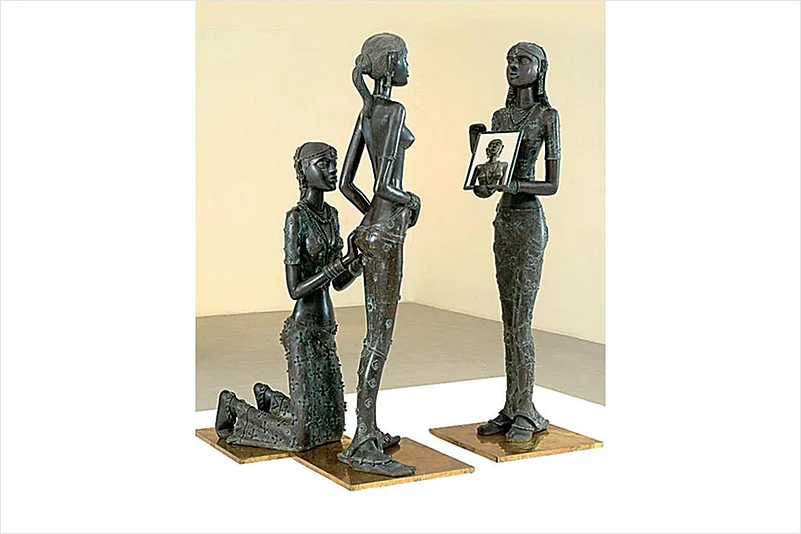
A. Ramachandran sculpture
Some large-scale sculptures outside the country are by Indians, says Bose Krishnamachari, artist and co-founder of the Kochi-Muziris Biennale. “For instance, Anish Kapoor’s Cloud Gate (2006) in Chicago,” he points out. Citing Cells of Life, the symbolic landforms done by Americal cultural theorist Charles Jencks outside Edinburgh in 2010, Krishnamachari adds: “For that to happen in India, we need industrial-type foundries, a support system and huge space.”
A remarkable oddity on the landscape came up in Malampuzha, near Kerala’s oldest dam, in 1969, when Kanayi Kunhiraman completed Yakshi: a 30-foot-high, concrete sculpture of a supernatural woman in the nude. Malayali prudishness did play out initially, with some protests, but aesthetes by and large recognised it as an epoch-defining work. “Today, Kerala does have an atmosphere where sculptors can survive, even flourish,” says 80-year-old Kunhiraman, who has since dotted the coast with several such huge works.
There’s indeed life in this special ecological zone. The Mangalore-born Sudarshan Shetty, like fellow Mumbaikar and Kochi-Muziris colleague Riyas Komu, gets his casting done in Baroda and then assembles. In Jaipur, Thomas Kovoor runs a big studio where his peers and juniors from across India camp to work in bronze. Delhiite Sumedh Rajendran has caught the eye with his novelty of conception and industrial materials. Recently, Bangalore got a sculpture garden commissioned, holding out the prospect of sponsorship, while a sunken courtyard in a 1930s-vintage Calcutta building now hosts the Experimenter gallery, an alternative space and curatorial endeavour by owner-couple Prateek Raja and Priyanka.
“Things are changing. It’s much less labour-intensive and time-consuming for the new generation,” says Vasudev, 76. “You get very good tools too.” So one sees a string of cutting-edge works: M.S. Umesh’s self-destruct sculpture video Statues Status (2005), Anita Dube’s Keywords (2005), a pedagogical performance involving sculpted meat-words, Shetty’s collapsible sculpture Paper Moon (1995) and For Here or To Go (2002), Kausik Mukhopadhyay’s recent Squeeze Lime in Your Eye, a kinetic sculpture improvised from found and readymade objects.
Still, they don’t enter the retail zone quite as easily. Gallerist Prashant Lahoti of Hyderabad blames the ‘apartment culture’, the space constraint at homes. “Our shows at Kalakriti feature roughly one sculpture to every four or five paintings we exhibit.” Scholar Sadanand Menon is sardonic: “Many wealthy homes consider it fashionable to hang a painting of contemporary masters. Likewise, they should place that little statuette in the drawing room—just to announce they have arrived in high society.”

A work by Sumedh Rajendran
But ‘trends’ create their own momentum. The first decade of this century, as Kerala’s Lalithakala Akademi chairman T.A. Sathyapal says ruefully, saw art school teachers prompting students to opt for painting, which was then experiencing a boom. “Even those who wanted to take up sculpting were discouraged,” he says. Art teacher Narendra Raghunath of Bangalore notes the para-dox of monumental sculptures of Shivaji and Sardar Patel coming up at the same time, “almost like a throwback to the 10th-century Gommateshwara statue in Shravanabelagola.”
Sarala Banerjee, who runs Chennai’s Artworld, faults her metro’s commercial complexes for “ignoring” sculptors. “South India is the capital of sculpture, yet there’s little support. Maybe the government can push for installing artworks in, say, malls. They could go for the cheapest Mahabalipuram statue—even that would be a beginning,” she says. Despite the costs, she sees sales of smaller pieces going well for Tamil sculptors like Velmurugan, Singaravelan and Vijay Velu, besides P.S. Nandan (see box).
Adajania speaks of a basic incongruence between sculpture and the “anaesthetised” gallery space—the open air is a more natural habitat for her, with its potential for interaction with the setting and with people. Advaita Gadanayak, artist and head of the National Gallery of Modern Art, cites the more practical fear gallery owners have of big sculptures damaging the interiors. Says curator Uma Nair, who was associated with NGMA’s big sculpture exhibition this summer as part of its 63rd founding year: “Sculptures need to be brought to public spaces. Like Arun Pandit’s Garuda that stands at Tirupathi airport.”
The relative invisibility, functioning almost like a binary caste system within the artworld, isn’t all that new. Ramachandran, who has added 13 self-done sculptures to his 1983 masterpiece Yayati, a 60-feet-long mythworld of murals, speaks of post-Ramkinkar sculptors like S.K. Bakre, K.S. Radhakrishnan, Navjot Altaf and Prodosh Dasgupta. “They have all done great, innovative work. But they haven’t found the deserving spot in the Indian narrative,” he shrugs.
More than their mere existence, art historian R. Sivakumar’s lens alights on the language of sculpture itself. The Visva-Bharati professor speaks of a “dip” after the death in 1980 of Ramkinkar, who kneaded a modernist idiom entirely out of Indian aesthetic soil. “What we saw for two decades thereafter was the referencing of artists from the West, such as Henry Moore,” says Sivakumar. “Yet we also saw Kanayi and later Mrinalini Mukherjee, Radhakrishnan and T.V. Santhosh emerging”—artists who had an autonomy of spirit beyond the unconscious traces they carried.
By the early 2000s, community art flourished. Adajania cites Navjot Altaf’s collaborative work in Bastar where they built elegant wraparound screens around pilla gudis (hand-pumps), a real, usable aesthetic space. Adds Suresh K. Nair, who teaches visual art at BHU: “Today, you have site-specific sculpting. Someone, say, goes to the forest and works on a stray boulder to turn it into a piece of art.”
From malls to forests, galleries to village squares, the potential hosts won’t be inert spaces: each will impose and derive its own meaning. But this misfit of our times will also speak of our times, of our deranged fears, our heightened sense of territoriality and narrowing space, to some future archaeologist. If we allow it to. As Ramachandran says regretfully, “But then, people want sculptures to have more representational value than artistic.”
By Sreevalsan Thiyyadi with inputs from Stuti Agarwal, Minu Ittyipe, G.C. Shekhar, Ajay Sukumaran, Prachi Pinglay-Plumber, Dola Mitra






